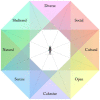Layered habitats: An evolutionary model for present-day recreational needs
- PMID: 36582316
- PMCID: PMC9793991
- DOI: 10.3389/fpsyg.2022.914294
Layered habitats: An evolutionary model for present-day recreational needs
Abstract
Urbanisation and lifestyle-related illnesses increase globally. This highlights the need to shape modern human habitats to support basic recreational needs, promoting such things as physical activity and restoration of high stress levels and cognitive fatigue. Previous research suggests eight perceived qualities in the outdoor environment, described as eight perceived sensory dimensions, as universally meaningful to people in this regard. However quite extensively studied in relation to various health and wellbeing outcomes, human sensitivity and appreciation for these qualities has not yet been explicitly analysed from an evolutionary perspective. This paper investigates their possible evolutionary roots and suggests an order for their development. This is linked with empirical findings on their relative capacity to support restoration of stress and cognitive fatigue. Qualities of earlier origin are suggested to correspond to older, more fundamental adaptations. Each subsequently developed quality implies an increased complexity of our environmental relations, associated with higher demands on more recently developed capacities. The proposed model thus links the more restorative Serene, Sheltered, Natural, and Cohesive perceived sensory dimensions with earlier stages of our development while the more demanding Diverse, Open, Cultural, and Social qualities are associated with more recent transitions. It might be of relevance when shaping modern human habitats from a health-promoting perspective, and have applications in the planning and design of, e.g., health care settings, rehabilitation gardens, urban green areas, recreational forests or other similar outdoor environments.
Keywords: cultural ecosystem services; evolutionary aesthetics; health and wellbeing; human habitats; landscape preferences; outdoor recreation; perceived sensory dimensions; restoration.
Copyright © 2022 Stoltz.
Conflict of interest statement
The author declares that the research was conducted in the absence of any commercial or financial relationships that could be construed as a potential conflict of interest.
Figures






Similar articles
-
The Effects of Urban Natural Environments on Preference and Self-Reported Psychological Restoration of the Elderly.Int J Environ Res Public Health. 2021 Jan 9;18(2):509. doi: 10.3390/ijerph18020509. Int J Environ Res Public Health. 2021. PMID: 33435508 Free PMC article.
-
Using Structural Equation Modeling to Examine Pathways Between Environmental Characteristics and Perceived Restorativeness on Public Rooftop Gardens in China.Front Public Health. 2022 Feb 24;10:801453. doi: 10.3389/fpubh.2022.801453. eCollection 2022. Front Public Health. 2022. PMID: 35284385 Free PMC article.
-
What Characteristics of Urban Green Spaces and Recreational Activities Do Self-Reported Stressed Individuals Like? A Case Study of Baoji, China.Int J Environ Res Public Health. 2019 Apr 15;16(8):1348. doi: 10.3390/ijerph16081348. Int J Environ Res Public Health. 2019. PMID: 30991673 Free PMC article.
-
Impacts of Human Recreation on Brown Bears (Ursus arctos): A Review and New Management Tool.PLoS One. 2016 Jan 5;11(1):e0141983. doi: 10.1371/journal.pone.0141983. eCollection 2016. PLoS One. 2016. PMID: 26731652 Free PMC article. Review.
-
[What is the scientific evidence with regard to the effects of forests, trees on human health and well-being?].Sante Publique. 2019 May 13;S1(HS):219-240. doi: 10.3917/spub.190.0219. Sante Publique. 2019. PMID: 31210482 French.
Cited by
-
Discovering the sensory, emotional, and interactive experiences of a place.Front Psychol. 2024 Jun 5;15:1303397. doi: 10.3389/fpsyg.2024.1303397. eCollection 2024. Front Psychol. 2024. PMID: 38899129 Free PMC article.
-
Interdisciplinary approach to defining outdoor places of knowledge work: quantified photo analysis.Front Psychol. 2023 Dec 1;14:1237069. doi: 10.3389/fpsyg.2023.1237069. eCollection 2023. Front Psychol. 2023. PMID: 38106383 Free PMC article.
References
-
- Aboitiz F., Montiel J. F. (2012). From tetrapods to primates: conserved developmental mechanisms in diverging ecological adaptations. Prog. Brain Res. 2012, 3–24. doi: 10.1016B978-0-444-53860-4.00001-5 - PubMed
-
- Adevi A., Grahn P. (2012). Preferences for landscapes: a matter of cultural determinants or innate reflexes that point to our evolutionary background? Landsc. Res. 37, 27–49. doi: 10.1080/01426397.2011.576884 - DOI
-
- Appleton J. (1975). The experience of landscape. JohnWiley, London.
LinkOut - more resources
Full Text Sources

